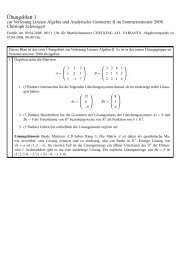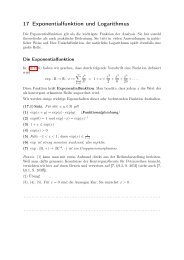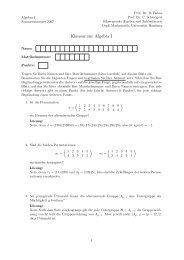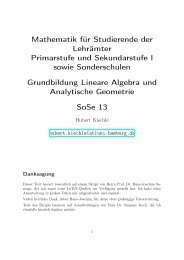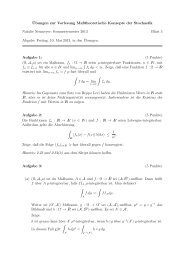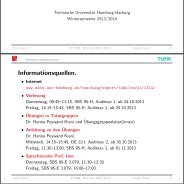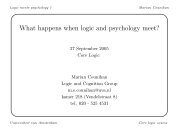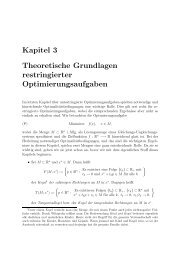pdf file
pdf file
pdf file
You also want an ePaper? Increase the reach of your titles
YUMPU automatically turns print PDFs into web optimized ePapers that Google loves.
analogy.<br />
✷<br />
The following simple lemma will be useful in many places:<br />
Lemma 2.5.7.<br />
Let H be a Hopf algebra with invertible antipode. Then<br />
S −1 (a (2) ) ∙ a (1) = a (2) ∙ S −1 (a (1) ) = 1 H ɛ(a) for all a ∈ H .<br />
Proof.<br />
The following calculation shows the claim:<br />
S −1 (a (2) ) ∙ a (1) = S −1 ◦ S ( S −1 (a (2) ) ∙ a (1)<br />
)<br />
= S −1 ( S(a (1) ) ∙ a (2)<br />
)<br />
= S −1 (1 H )ɛ(a) = 1 H ɛ(a)<br />
[ S is antialgebra morphism]<br />
The other identity is proven analogously.<br />
✷<br />
Remark 2.5.8.<br />
Let H be a bialgebra. An endomorphism ˜S : H → H such that<br />
∑<br />
S(x (2) )x (1) = ∑ x (2) S(x (1) ) = ɛ(x)1 H for all x ∈ H<br />
x<br />
x<br />
is also called a skew antipode. We will usually avoid requiring the existence of an antipode<br />
and of a skew antipode and impose instead the stronger condition on the antipode of being<br />
invertible.<br />
Corollary 2.5.9.<br />
1. If H is either commutative or cocommutative, then the identity S 2 = id H holds.<br />
2. If H and K are Hopf algebras with antipodes S H and S K , respectively, then any bialgebra<br />
map ϕ : H → K is a Hopf algebra map, i.e. ϕ ◦ S H = S K ◦ ϕ.<br />
Proof.<br />
1. If H is commutative, then<br />
x (2) ∙ S(x (1) ) = S(x (1) ) ∙ x (2)<br />
defn. of S<br />
= ɛ(x)1 H .<br />
From the previous proposition, we conclude that S 2 = id H . If H is cocommutative, then<br />
Again we conclude that S 2 = id H .<br />
x (2) ∙ S(x (1) ) = x (1) ∙ S(x (2) )<br />
defn. of S<br />
= ɛ(x)1 H .<br />
36






